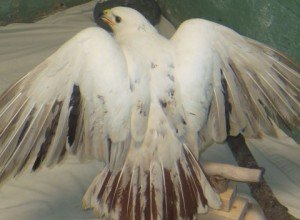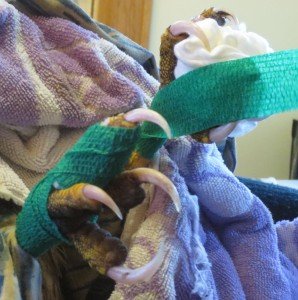
In case you were wondering, it’s difficult to type when your hands are clenched in the shape of a man’s neck.
Check out the beautiful white Red-tailed Hawk in the photo above. If she an albino or leucistic? True albinos are unable to produce the skin pigment melanin, although they can produce other skin pigments which can give feathers or skin a pale yellow color. Leucism, however, is the result of reduced coloration of all types of skin pigments, which sometimes leads to mottled coloring and patches of white.
True albinos supposedly have red or pink eyes, while leucistics’ eyes are normal color. However, ongoing research at Sia Essential Species Repository (see below) reveals this is not always the case, and that there are actually five phases between albino and leucistic. What is important to this particular hawk, though, is not the color of the feathers on her body but of the bandages on her feet, as she was caught in a double leg hold trap set for raccoons.
“I’ve seen her around, when I was setting my traps,” said the trapper himself, who brought her to Tamarack Wildlife Center, in Saegertown, PA. “Just the other day I was saying that I hope I never catch her.”
Personally, I’m thinking the exact opposite about the trapper. This is why certain wildlife rehabilitators end up misanthropic and homicidal.
But luckily for wildlife there are people like Carol Holmgren, the Executive Director of the Tamarack Wildlife Center. When the trapper appeared with the hawk in a box, Carol kept both her temper and her wits and convinced him to bring her any non-targeted wildlife he catches, as well as to refrain from simply letting them go (“I’ve set hawks free before, because they could still fly.”)
With additional luck, the trapper will spread the word among his trapper friends – all those wildlife-savvy, close-to-the-land folk who believe that raptors beat their prey to death with their wings instead of using the talons that have been nearly severed by leg-hold traps.
The white redtail couldn’t fly because she’d spent somewhere between 14 and 24 hours on the ground in freezing rain, encased in mud, and was suffering from capture myopathy, a sometimes-fatal condition induced by stress. When a muscle is used, its metabolism changes from aerobic (uses oxygen) to anaerobic (using stored energy), which produces lactic acid. The buildup of lactic acid leads to decreased heart function, then to the death of muscle cells, then the breakdown of internal organs. Death can occur instantaneously, or days/weeks/months later.
Carol treated the redtail immediately by warming her up and administering fluids, both to increase her blood volume and to dilute her blood’s acidity. Tamarack’s veterinarian, Dr. Kevin Ramey of Animal Ark Pet Hospital in Erie, PA (who donates his time), treated her with non-steroidal anti-inflammatories and antibiotics, then five days later, surgically removed one hopelessly damaged talon.
Wildlife centers depend heavily on the advice of veterinarians who work with wildlife, and who often exchange treatments and experiences with each other. Also providing advice were Dr. Jamie Lindstrom of the VCA Northview Animal Hospital in Pittsburgh, and Dr. Erica Miller, formerly of Tri-State Bird Rescue in Delaware.
Rehabilitators at Tamarack are now treating the redtail with antioxidants as well as providing hydrotherapy and continuing wound care, all the while trying to handle her as little as humanly possible. Will she be releasable? It’s too soon to tell. If all her other toes eventually function perfectly, she could still hunt without that one non-essential talon.
White hawks hold special religious significance for many Native American tribes. If she is not releasable, she will either stay at Tamarack or be placed with Sia Essential Species Repository, a Comanche organization that breeds albino and leucistic hawks for research, and makes their molted feathers available to Native religious elders.
“It is a privilege to treat her,” says Carol, who is part Shawnee. “She is a medicine bird. I believe she brings blessings to the center and to everyone who treats her. I hope we can release her.”













Thank you for sharing this story and to everyone who is trying to help ease this bird’s suffering.
Thank you! And I’m hoping the same, Suzy.